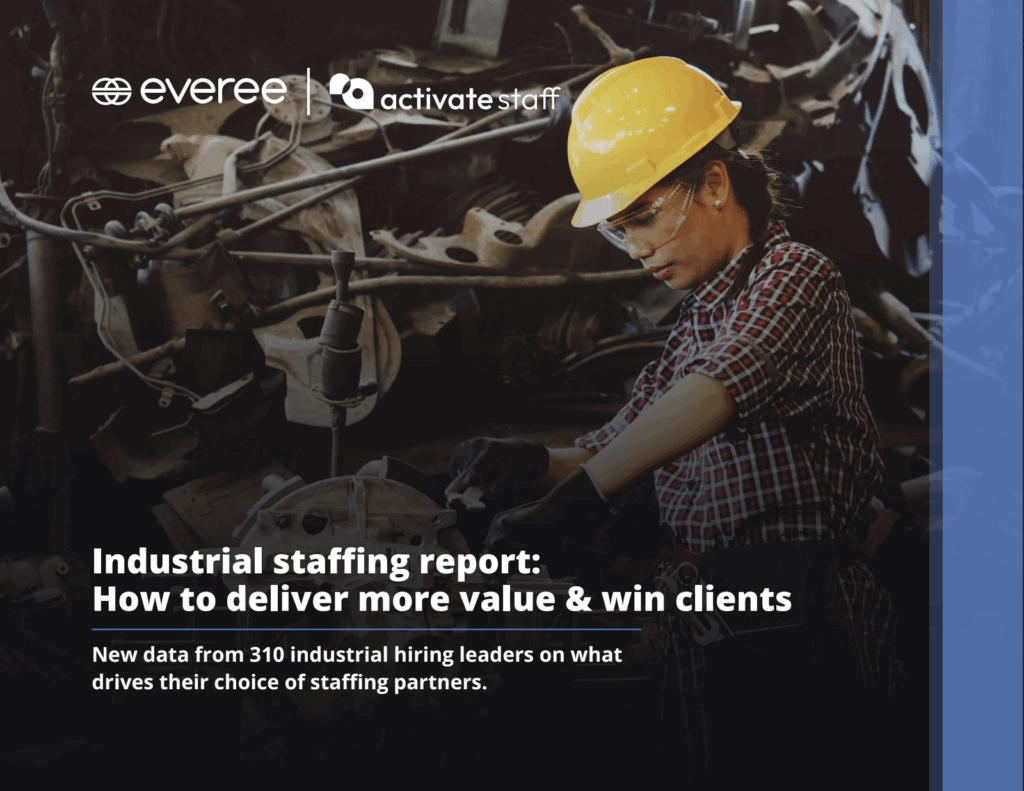New data from 310 industrial hiring leaders on what drives their choice of staffing partners.
The staffing wake-up call
Stop me if you’ve heard this one before: your client calls on a Friday afternoon, desperate for twenty reliable workers by Monday. Your recruiters scramble, your team pulls overtime, and by some miracle, you deliver. The client is happy, for now. But you can feel it: the bar keeps rising, and the old ways of winning business aren’t enough anymore.
That’s the reality in 2025. Industrial staffing has never been more essential, and never more scrutinized. The firms you serve in manufacturing, logistics, and construction are growing despite severe labor shortages. Nearly two-thirds of hiring leaders say the shortage is directly hampering operations, and yet, 68% still plan to increase headcount this year. They’re counting on staffing partners to bridge that gap quickly and reliably.
The good news: almost every company already uses temporary workers, and most believe it makes them faster, more flexible, and more efficient. The challenge? They’re demanding. Speed, quality, and industry know-how aren’t “nice-to-haves”, they’re make-or-break. Nearly eight in ten companies have already switched agencies at least once, often for reasons as simple (and brutal) as slow fills, unreliable temps, or poor communication.
This report from Everee and ActivateStaff, based on a survey of 310 U.S. industrial hiring leaders, digs into what these clients really think about staffing agencies: the benefits they see, the frustrations that drive them away, and the expectations that define success. It also highlights where forward-looking agencies are gaining an edge, by blending human expertise with modern tools that improve speed, reliability, and trust.
If you’re leading an industrial staffing firm in 2025, the message is clear: clients are leaning on you more than ever, but they won’t settle for less than excellence. In the pages that follow, you’ll see exactly what they value, what they expect, and where you need to evolve to stay ahead.
RELATED: Register for the 2025 Staffing Wake-up Call Webinar, September 25, with leaders from QPS Staffing, The Reserves Network, ActivateStaff and Everee.
Who we surveyed
This report is built on insights from 310 hiring leaders in the U.S. industrial economy, spanning manufacturing, logistics, and construction. Respondents represent a mix of company sizes, roles, and decision-making levels, ensuring a balanced view of how staffing fits into workforce strategy today. Respondents were evenly distributed across the U.S.
Respondent Roles
- Executive leadership (CEO, COO, CFO, VP) – 41%
- Director of HR or Operations – 38%
- Supervisors/Frontline Managers – 21%
Decision-Making Authority
- Final decision makers – 62%
- Part of decision-making team – 31%
- Influencers, not final decision makers – 7%
Industry representation
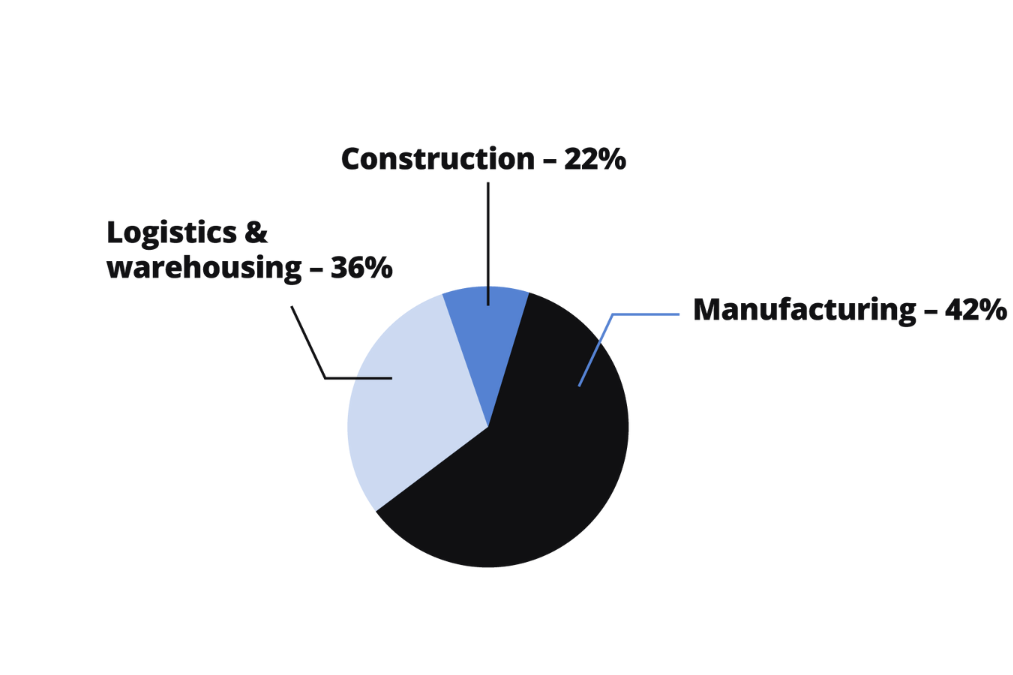
Company size
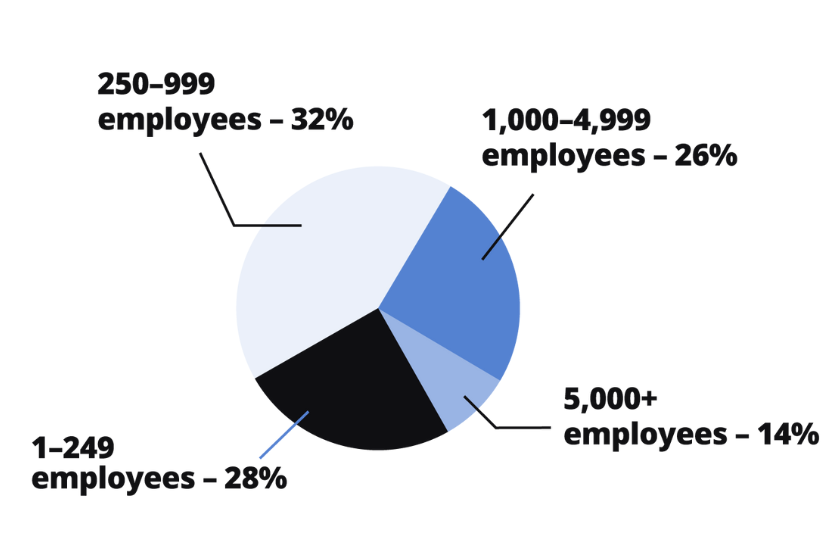
The talent crunch is real
Every staffing leader knows finding qualified workers is tough. The data confirms just how deep the problem runs for the clients you serve. In our survey of 310 hiring leaders across manufacturing, logistics, and construction:
- 66% said the labor shortage is having a “high impact” on operations (rating it a 4 or 5 on a 5-point severity scale). Only 8% reported low impact.
- “Difficulty finding qualified workers” ranked as the number one workforce challenge, outranking turnover, rising costs, and training needs.
- Despite these hurdles, 68% of companies still expect to increase headcount over the next year. Only 4% anticipate a decrease.
Growth collides with scarcity
This paradox, wanting to expand in the middle of a shortage, creates intense pressure on staffing agencies. Companies are forging ahead with new shifts, facilities, and contracts, but without enough workers to fill them.
Planned operational changes to cope with labor shortages
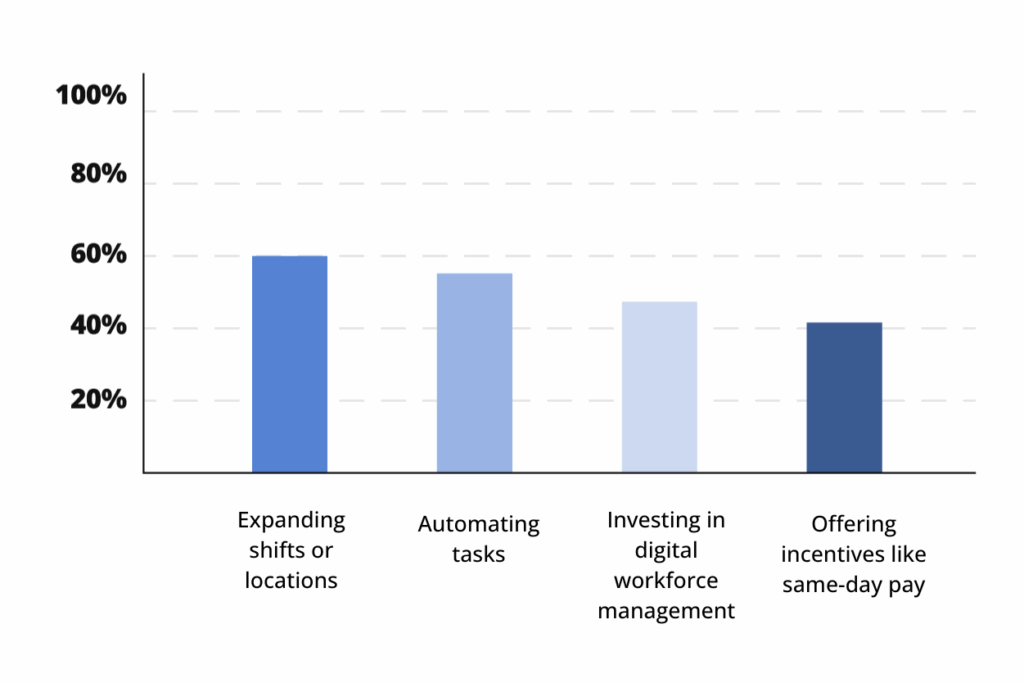
In fact, 90% of respondents are making operational changes to cope, such as:
- 60% expanding shifts or locations (e.g., adding night shifts or new facilities)
- 52% automating tasks to reduce dependency on scarce workers
- 47% investing in digital workforce management tools like scheduling and timekeeping
- 41% offering incentives like same-day pay to attract and retain staff
The implication for staffing firms
These adjustments help, but they don’t solve the core problem. When the number-one pain point is simply finding qualified workers, internal tweaks can only go so far. That’s why external staffing support is no longer optional. Companies are leaning harder than ever on agencies to supply talent quickly, reliably, and at scale.
The opportunity is huge. But so is the risk: agencies that can’t deliver on speed or candidate quality risk being cut from the roster.
Strategies for filling workforce gaps
When shifts are short-staffed, industrial leaders don’t have the luxury of waiting weeks for a solution. They need fixes now. Our survey reveals how companies respond in the moment, and it highlights just how central staffing agencies have become to that playbook.
Primary response to being short-staffed

Overtime is still the knee-jerk reaction, but not the only one
- 32% turn first to overtime for current employees.
- 31% hire temps through staffing agencies as their top choice.
- 19% hire temporary or contract workers directly.
- Only 10% reallocate staff internally, and 8% slow or delay production.
The takeaway: overtime may edge out as the most common first move, but agencies are essentially tied as the go-to solution. Internal shuffling or slowing work are far less palatable.
Top uses cases for temporary staffing

Beyond primary tactics, almost every company we surveyed uses temps in some form. Only 3% say they “generally do not use temps.” The most common use cases include:
- Seasonal peaks or surges (64%)
- One-off projects or contracts (46%)
- Covering employee absences (46%)
- Hiring freezes (32%)
- Temp-to-hire trials (46%)
- Ongoing pools to offset chronic shortages (37%)
This isn’t stop-gap thinking, it’s strategic. Companies have woven temp staffing into their workforce model as a standard lever they can pull.
A meaningful slice of the workforce
For most firms, temps make up 5–20% of their workforce. Specifically:
- 52% report temps are 5–10% of staff
- 31% say 11–20%
- Only a small minority (3%) rely on temps for more than 20%
In other words, contingent labor may not be the majority, but it’s a consistent, significant cushion that keeps operations running.
Why agencies edge out direct hires
It’s worth noting: half of companies choose temp labor as their primary response, and a slight majority of those prefer using agencies over doing it themselves. The reason is simple, speed. Agencies give them faster access to qualified candidates, without the administrative drag.
What this means for staffing firms
When industrial leaders face workforce gaps, staffing agencies are right at the top of the list. That’s good news, but it also means expectations are sky-high. You’re being compared directly to the “easy button” of overtime. If your fill process isn’t faster and more reliable than paying current staff extra hours, you risk being sidelined.
Benefits of temporary staffing and ROI
Why do industrial leaders keep coming back to staffing agencies? The answer is clear in both perception and hard numbers: agencies deliver speed, flexibility, and measurable savings.
Top benefits of using temporary staffing
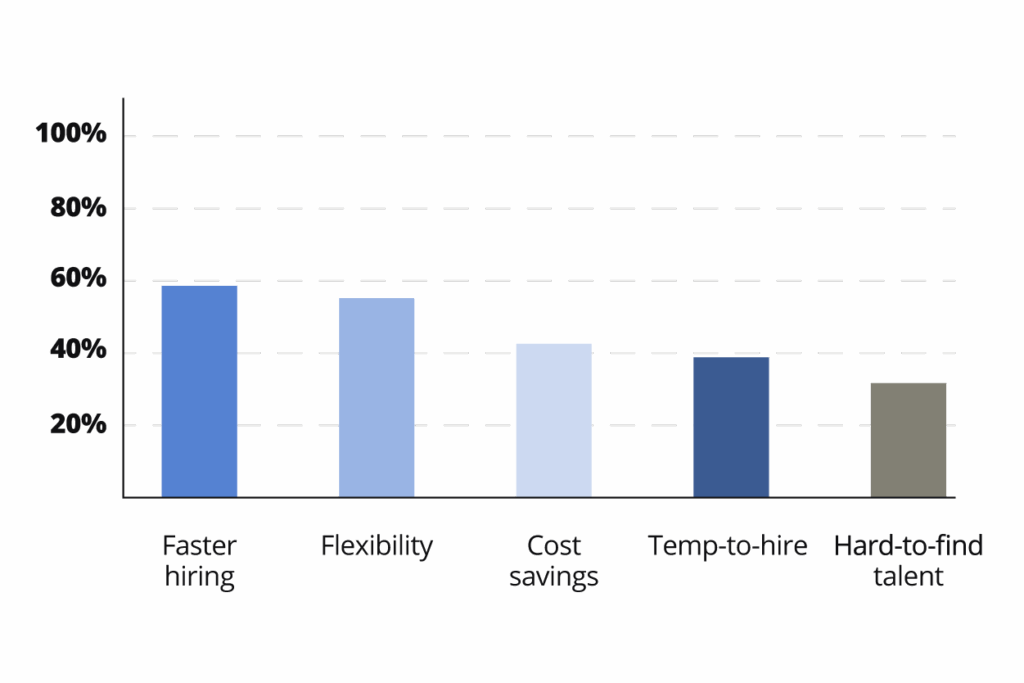
Faster hiring is the headline value
When asked to name the top benefits of using temporary staffing:
- 58% selected faster hiring as a primary advantage.
- 55% cited the flexibility to scale labor up or down quickly.
- 41% pointed to cost savings on benefits and long-term commitments.
- 39% highlighted reduced risk through temp-to-hire.
- 34% said staffing agencies help them access hard-to-find talent.
Only 2% said they saw little or no benefit. That means 98% of leaders see real, tangible value in temporary staffing.
Flexibility and efficiency gains are undeniable
This isn’t just anecdotal. 83% of leaders agree temporary staffing makes their companies more flexible and efficient, with nearly half strongly agreeing. In industries where downtime can cost millions, that kind of efficiency edge is critical.
Real financial savings
Temporary staffing doesn’t just fill shifts, it saves money. Nearly three-quarters of leaders report annual savings of at least $25,000 thanks to temp staffing:
- 38% save $100,000–$249,999 per year.
- 35% save $25,000–$99,999.
- 11% report savings of $250,000 or more.
- Only 12% save less than $25k or none at all.
Time is money, and agencies save both
The productivity side is just as striking:
- 45% save 500–1,999 hours annually by using temp staffing.
- 27% save 2,000–4,999 hours.
- 5% save more than 5,000 hours, the equivalent of three full-time employees.
These savings aren’t theoretical. They translate into fewer missed deadlines, less overtime burnout, and more bandwidth for internal teams to focus on growth.
Reducing risk with “try before you buy”
Nearly 40% of firms use temp-to-hire as a way to de-risk full-time hiring. This extended audition not only reduces hiring mistakes but also strengthens workforce quality over time. Good temps often become great full-time employees.
What this means for staffing firms
For agencies, these numbers are more than just bragging rights, they’re a tool to build stronger client relationships. Too often, the value of staffing is invisible: a line item on an invoice rather than a strategic advantage. By quantifying cost avoidance (less overtime, fewer benefits payouts, reduced turnover costs) and time saved (thousands of hours that internal HR and operations teams get back), agencies can reframe the conversation.
Instead of debating bill rates, you can show how your partnership protects margins, prevents burnout, and accelerates growth. In other words, you’re not just filling jobs, you’re delivering measurable business outcomes.
What industrial clients expect from staffing agencies
Industrial firms don’t just want bodies on the line. They want the right people, fast, and backed by a partner who understands their world. The survey data makes one thing clear: expectations are sky-high and unforgiving.
Quality is the non-negotiable
When choosing an agency, the number-one factor is candidate quality and reliability. If placements don’t show up, can’t perform, or leave after a week, the relationship is at risk, no matter how good your pricing or technology may be.
Close behind:
- Industry specialization was the second most important factor. Leaders value agencies that understand the skills, certifications, and safety standards specific to manufacturing, logistics, or construction.
- Speed of fulfillment ranked third. Most firms need roles filled within days, not weeks.
- Competitive pricing came fourth, important, but clearly secondary to quality and speed.
Time-to-fill expectations are razor-thin
Almost nine in ten companies expect positions filled in under a week. More striking:
- 61% expect roles filled within 48 hours.
- 13% expect them filled in less than 24 hours.
Time-to-fill expectations
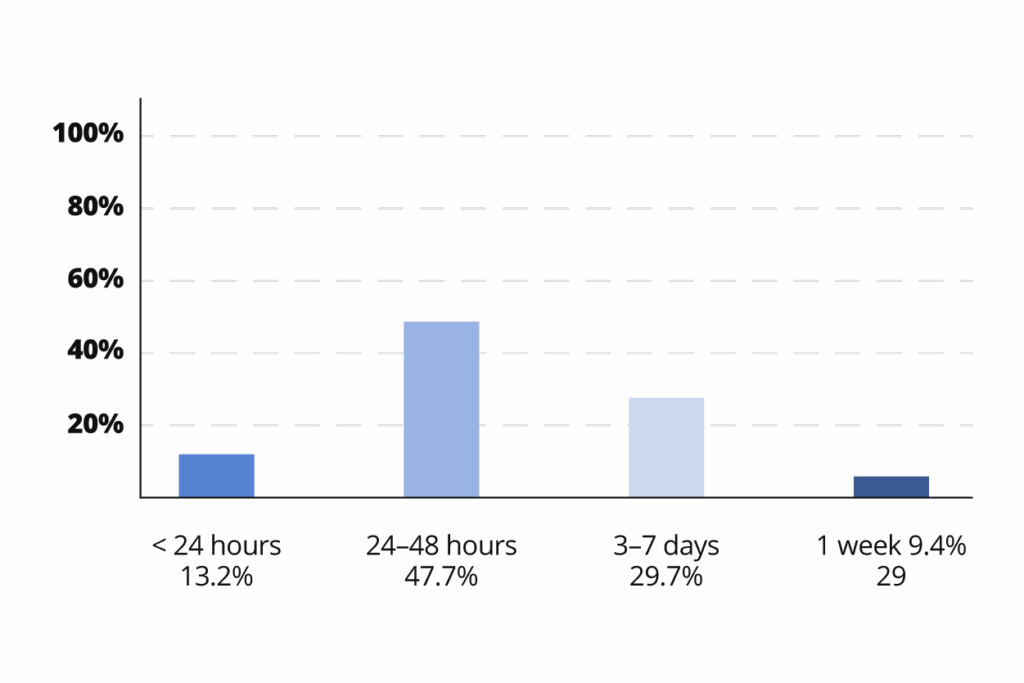
This benchmark means agencies must always have talent pipelines ready to go. A vacancy that lingers even a few days could cost a client a production line, a shipment deadline, or a contract.
Satisfaction is high, but loyalty is fragile
Encouragingly, most companies are happy with their current agencies:
- 36% are very satisfied
- 45% are satisfied
- Only 1% are dissatisfied
That’s an average satisfaction rating of about 4.2 out of 5.
But here’s the catch: nearly 77% of companies have switched agencies before, usually over issues like slow fulfillment, poor communication, or unreliable temps. Satisfaction doesn’t guarantee loyalty, service lapses do not get forgiven.
What this means for staffing firms
Clients are clear about what they want:
- Qualified, reliable candidates who fit the role.
- Specialized expertise in their industry.
- Faster fills than overtime can provide.
Everything else, pricing, tech, even relationships, comes after those fundamentals. If you can’t deliver on the basics, you won’t keep the business. If you can, you’ll have the chance to prove your value in deeper, more strategic ways.
Pain points: Why clients switch agencies & barriers to more temp usage
High satisfaction doesn’t mean guaranteed loyalty. Our survey shows most companies have switched or dropped a staffing agency at some point, and the reasons point squarely to gaps in fundamentals.
Why clients walk away
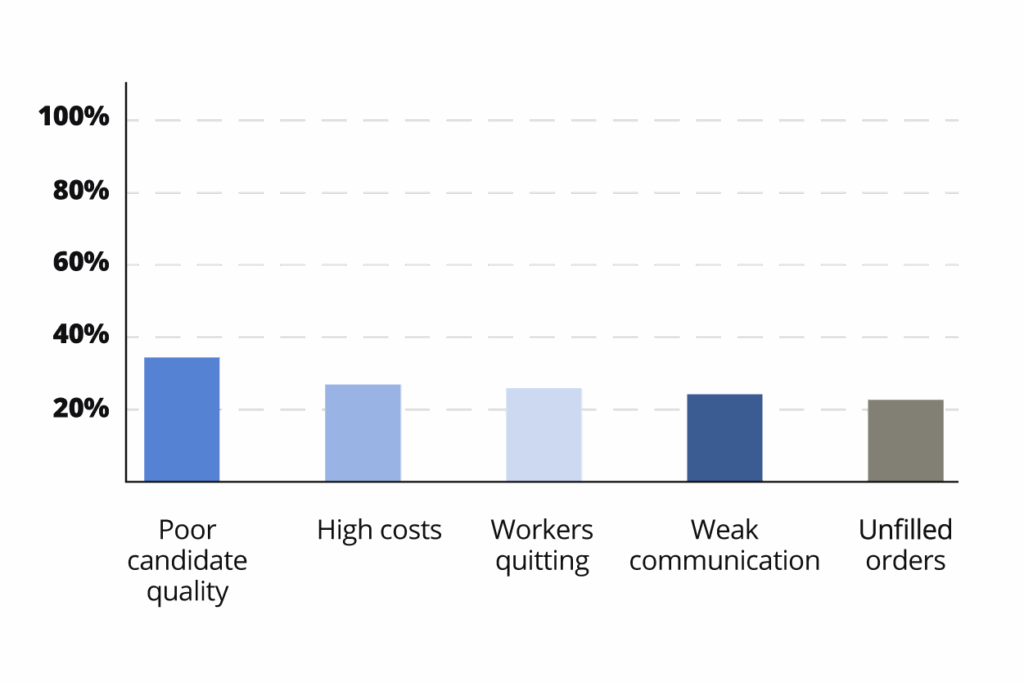
77% of companies have replaced an agency over performance issues. The top reasons:
- Poor candidate quality or fit (34%)
- High costs or bill rates (26%)
- Workers quitting or not showing up (25%)
- Weak communication or service (24%)
- Slow fulfillment / unfilled orders (23%)
Other factors, like safety concerns (21%), billing errors (17%), or lack of industry understanding (21%), were less common but still significant.
The pattern is unmistakable: if an agency stumbles on quality, reliability, or responsiveness, clients won’t hesitate to move on.
Barriers to using more temp staff
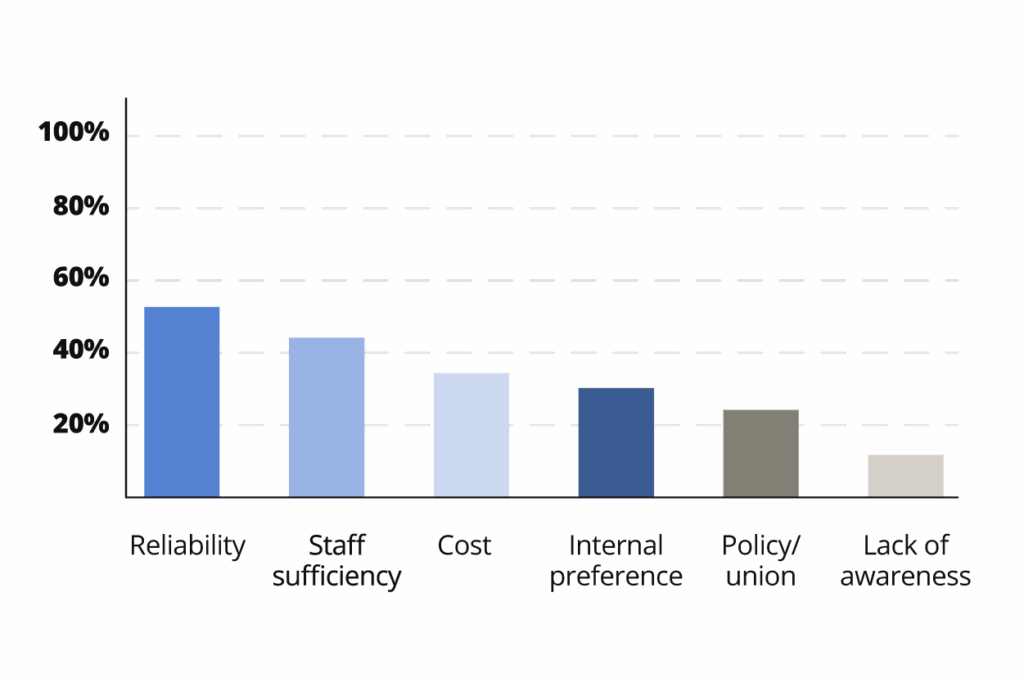
Even when agencies perform well, some clients hesitate to expand their use of contingent labor. The most common barriers are:
- Concerns about temp worker reliability/performance (55%)
- Satisfaction with current full-time staff levels (45%)
- Perceived high cost of temps (37%)
- A preference to hire/train internally (35%)
- Company policy or union restrictions (27%)
- Lack of familiarity with staffing agency services (15%)
These barriers show why temp staffing doesn’t automatically grow, even when clients are satisfied. Cultural resistance, cost perceptions, and reliability concerns all play a role.
What this means for staffing firms
To expand usage and strengthen loyalty, agencies must address these pain points head-on:
- Guarantee reliability by vetting thoroughly, tracking attendance, and offering quick replacements for no-shows.
- Shift the cost conversation by showing the total workforce impact, how temp staffing reduces overtime, turnover, and lost productivity.
- Position temp workers as allies, not outsiders and emphasize how they support and protect core employees rather than replace them.
- Educate clients who are unfamiliar with modern staffing models, highlighting advances in safety, compliance, and technology.
Clients want reassurance that temp staffing won’t compromise performance or culture. The agencies that can build this trust, and prove their value with data, will be the ones that turn satisfied customers into loyal, long-term partners.
Modernization isn’t optional anymore
In industrial staffing, tradition runs deep. Many agencies have built strong businesses on relationships, local presence, and dependable service. But the industry is shifting, fast. Clients are signaling that while quality and speed remain the non-negotiables, agencies also need to show they’re modern, future-ready partners.
Tech is a differentiator, not a distraction
When asked to rank what matters most in choosing an agency, technology tools came last. But here’s the nuance: nearly 50% of leaders agreed that agencies not using AI risk feeling “out of date.” Clients may not demand fancy apps up front, but they notice when a provider is behind the curve.
For agencies, that means technology isn’t a substitute for quality and speed, it’s the infrastructure that enables both. Tools like:
- AI-driven candidate matching to cut time-to-fill.
- Mobile apps and self-service portals for faster worker engagement and scheduling.
- Data dashboards to forecast client needs and track ROI.
- Automated payroll solutions that offer same-day pay, which 4 in 10 companies are already planning to offer to attract workers.
These aren’t gimmicks. They’re proof points that you can deliver the fundamentals, faster, cheaper, and more reliably.
Why modernization matters now
Clients themselves are modernizing:
- 52% are automating tasks to reduce dependence on scarce workers.
- 47% are investing in digital workforce management tools.
- 41% are offering incentives like same-day pay.
They expect their staffing partners to keep pace. If you’re still running on paper sign-in sheets, phone trees, and delayed payroll, you risk signaling you can’t support their future growth.
What this means for staffing firms
Modernization isn’t about chasing every shiny new tool, it’s about making sure your technology amplifies the basics. If clients care about faster fills, use AI to accelerate sourcing. If they value reliability, use mobile apps to confirm shifts and reduce no-shows. If they worry about cost, show them analytics that prove ROI.
The agencies that embrace tech not as a gimmick but as an enabler will stand apart. In a market where clients are ready to switch providers over speed or reliability, modernization can be the difference between being the vendor of choice and being left behind.
Looking ahead: The future of industrial staffing
The next few years will test the industrial staffing industry like never before. Labor shortages aren’t going away, client expectations will only rise, and digital-first competitors are circling. But the survey results also point to a clear future: agencies that adapt will not just survive, they’ll lead.
Three shifts to watch
- Clients will demand “always-on” staffing.
With 61% of roles expected to be filled within 48 hours, agencies will need to operate like 24/7 partners. Standing talent pools, real-time worker communication, and proactive forecasting will become table stakes. - Contingent labor will keep expanding.
Nearly every company already uses temps, and barriers like “cost” or “culture” can be addressed with education and data. Over time, temps will represent a larger slice of the workforce, especially as companies embrace temp-to-hire as a safe, low-risk pipeline. - Technology will quietly separate leaders from laggards.
Tech won’t replace relationships, but it will determine who delivers faster fills, fewer no-shows, and stronger reporting. Clients won’t choose agencies because of their apps, but they will leave agencies that feel slow, disorganized, or outdated.
The opportunity ahead
Despite the challenges, the data shows optimism. 68% of companies plan to grow headcount this year. That’s more jobs to fill, more contracts to win, and more chances to prove value. The firms that blend people-first service with smart modernization will be positioned not just as vendors, but as indispensable partners in their clients’ growth.
Conclusion: Be the partner they brag about
Industrial staffing in 2025 is both a challenge and an opportunity. Clients are leaning on agencies more than ever to solve the toughest problem in their business: finding reliable talent, fast. The survey data is clear: When agencies deliver on quality, speed, and industry know-how, the ROI for clients is undeniable. But it’s equally clear that loyalty is fragile. A single misstep in communication, candidate quality, or fulfillment speed can send a client searching for alternatives.
The winners in this market will be those who go beyond filling orders. They’ll show clients how staffing saves money, reduces risk, and unlocks growth. They’ll adopt the tools and processes that make speed and reliability the norm, not the exception. And most importantly, they’ll position themselves not just as suppliers of labor, but as partners in performance, the agencies clients brag about to peers, not just tolerate until something better comes along.
How Everee and ActivateStaff help agencies rise to the challenge
That’s where modernization becomes real. With Everee’s automated payroll, staffing agencies can offer same-day pay that keeps workers engaged and reduces turnover, directly addressing one of clients’ biggest concerns: reliability. Meanwhile, ActivateStaff’s workforce engagement platform gives agencies the digital infrastructure to fill jobs faster, confirm shifts in real time, and build scalable, loyal talent pools.
Together, Everee and ActivateStaff provide an integrated solution that empowers agencies to meet the demands of today’s industrial clients: attract workers, faster fulfillment, stronger reliability, and modern worker experiences that set you apart. In a market where expectations are only rising, this combination helps agencies deliver the fundamentals better, faster, and more consistently, so you can protect accounts, win new business, and be the partner your clients rave about.
RELATED: Register for the 2025 Staffing Wake-up Call Webinar, September 25, with leaders from QPS Staffing, The Reserves Network, ActivateStaff and Everee.
To learn more about Everee + ActivateStaff, book a demo today. To get a full copy of the report, click below:
